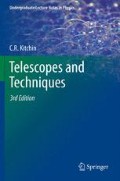Abstract
Observing time on major telescopes is usually allocated to individual astronomers or groups of astronomers a few nights at a time, and at most three or four such sessions might normally be available over a year. This does not mean that the astronomers concerned can relax for the other 50 weeks, but it is a measure of the relative efforts required at a research level in obtaining the data in the first place compared with the processing then needed. Usually many multiples of the time spent observing have to be spent afterwards working on the data (photographs, CCD images, spectra, photometric measurements, astrometric measurements, etc.) in order to get it into the finally desired form.
Access this chapter
Tax calculation will be finalised at checkout
Purchases are for personal use only
Notes
- 1.
Many scientific calculators and computer spreadsheets have pre-programmed algorithms to calculate standard deviations and also standard errors of the mean, correlation coefficients, t values and to undertake linear regression etc. The handbooks or help sections of the calculators or computers will need to be consulted for further details on how to use these facilities in specific cases.
- 2.
You may still be able to fit a least squares linear equation to a set of data points even when the physics of the phenomenon suggests that the relationship is not linear. For example, if theory suggests a quadratic equation (i.e., y = a x2 etc.) for a relationship, then y should have a linear relationship with √x and the linear regression formulae will give the linear least squares best fit for it. You should note, however, that this will not usually be quite the same as the quadratic least squares best fit to the same data, but it is much simpler to calculate and may be good enough to get the analysis started.
- 3.
This is not a simplified test suitable for students that is to be superseded by a better test for higher levels of work. The name comes from the statistician who devised the test, William Gosset. He wrote popular mathematics articles under the pen-name “Student.”
- 4.
1018 bytes. See Appendix D in this book for a list of the standard prefixes for very large and very small numbers.
Author information
Authors and Affiliations
Corresponding author
Rights and permissions
Copyright information
© 2013 Springer Science+Business Media New York
About this chapter
Cite this chapter
Kitchin, C.R. (2013). Data Processing. In: Telescopes and Techniques. Undergraduate Lecture Notes in Physics. Springer, New York, NY. https://doi.org/10.1007/978-1-4614-4891-4_10
Download citation
DOI: https://doi.org/10.1007/978-1-4614-4891-4_10
Published:
Publisher Name: Springer, New York, NY
Print ISBN: 978-1-4614-4890-7
Online ISBN: 978-1-4614-4891-4
eBook Packages: Physics and AstronomyPhysics and Astronomy (R0)

